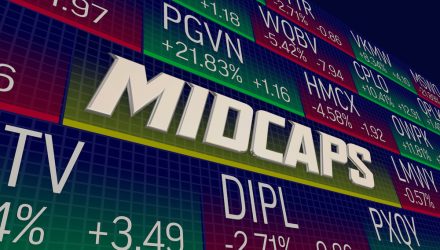Market uncertainty can certainly spill over into an investor’s portfolio. If growth prospects look bleak, an investor may want to tilt towards quality, but there’s one midcap exchange-traded fund (ETF) option that can quell the uncertainty.
Growth exposure is inherent in small-cap companies, but in times of distress, it can be a risky proposition. In the current economic climate, high borrowing costs could be a thorn in the side for small-cap companies that aren’t flush with cash to make strategic growth moves such as expanding operations.
As such, investors are flocking to the safety of large-cap companies that have the quality factor of companies that exhibit financial stability. In times of heavy market volatility and economic uncertainty, large-cap companies offer safe havens that risk-averse investors prefer.
Midcap companies, however, can reconcile the qualities of both small- and large-cap companies. Investors essentially get the best of both worlds, achieving growth exposure as well as quality.
Additionally, investors may want to add an environmental, social, and governance (ESG) component to their portfolios. Add a touch of active management to maintain pliability in the markets and you have the American Century Mid Cap Growth Impact ETF (MID).
The fund seeks to invest in midcap companies that do or could generate social and environmental impact alongside financial return.
MID uses proprietary fundamental research to:
- Identify midcap stocks that managers believe will increase in value over time.
- Identify companies that, according to the United Nations Sustainable Development Goals (SDG), do or could generate ESG impact alongside a financial return.
History on the Side of the Midcap
Now could be the time to take advantage of midcap exposure, especially if history repeats itself. Research shows that midcap companies could be offering an area of value that was subsequently followed by future upside.
“The last time relative valuations were this cheap, and sentiment so poor, was followed by an outstanding period of absolute and relative returns for small and mid-cap companies,” asset management firm Schroders noted. “In the seven-year period following the market peak in March 2000, small caps rose by more than 70% compared to a rise of less than 10% for large cap stocks.”
Furthermore, this strength occurred in a macroeconomic environment that is similar to now.
“This outperformance from smaller companies occurred during periods when interest rates and economic growth were both rising and falling – suggesting the outperformance can arise through a variety of economic environments,” Schroders added.
For more news, information, and strategy, visit the Core Strategies Channel.


